Learn about nature photography and its effects on your emotions.
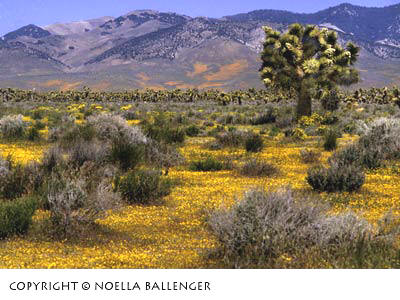
Each image in the Ming Medical Office facility had an information panel. We wanted to create an interesting and informative area for patients and their family’s to wait.
“A mysterious and alluring part of the Kern County landscape, the Mojave Desert offers many treasures to those willing to look past its seemingly desolate appearance. What may appear a barren landscape from a distance, is actually home to numerous unusual and beautiful species of plants and wildlife. Kern County’s ever-present California Poppy provides a golden backdrop for this unique Joshua Tree and the tiny, yellow goldfield that surround it.” (Ming Medical Center)
Recently I was talking with a friend and he mentioned that he loved photographing people because those images became a part of the visual history of the family. They were treasures and always appreciated. And he challenged me with the question, “Why do you shoot nature … it doesn’t have the same meaning or impact.”
There is nothing like a good challenge to get you to think through an idea. First, I have to agree with him that people images do have an impact and are cherished by family and friends. No question about that, but that brought me back to why nature and why I feel that there is also a tremendous impact from these photos on our lives in their own special way.
A number of years ago I had a personal tragedy in my life and, as I worked through the emotions, I found myself being drawn each evening to the light table and images that I had taken in various gardens. There was something compelling about looking at the images. I could feel the sun on my back and the same sense of peace and sense of serenity that came over me when I was using the camera. Later as my career path become more solidified, I decided that I wanted to … no I needed to … share that sense of relaxation and well being with others.
I began to review books and studies that talked about using nature images in locations such as hospitals and medical facilities. This was very interesting and certainly would allow me to share my passion for the natural world with others. One of the studies that I remember talked about people in one wing of one hospital. They were all there for a similar kind of operation. The rooms on one side of the wing faced a brick wall of another wing. Opposite those rooms were others that looked out over a parking lot toward some hills and trees. The amazing discovery that those researchers made was that the people who were on the side that faced the hills and trees, recovered faster, used less pain medications, had fewer side effects and usually were released more quickly than those that faced the brick wall.
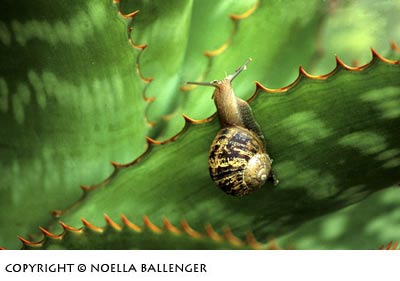
Behind the reception area was a large image of a snail crawling along an agave leaf. The purpose of using this image was to slow down the patient rush at the front desk. It is unusual enough to catch one’s interest and seemed to do the job. ( Dr. Reinisch Office)
It was exciting knowing that you didn’t actually have to experience walking in nature but could get good effects by merely looking at a photograph. So I began to study more and talk with architects, interior designers, medical people and artists. I learned that there are many beneficial reasons to incorporate atriums, fish tanks, planters and views of other natural things in buildings.
I learned about the effects of color as well and how color can be incorporated and used to evoke some feelings or even actions. For example, there is a very good reason one popular chain of fast food restaurants uses the “discordant” colors of orange and purple in their décor. They want a rapid turnover of tables and those colors don’t encourage people to linger. And pleasant colors that relax and sooth can have just the opposite effect. For example, many elegant, expensive restaurants that encourage lingering use color schemes that may shift through the soft browns in woods, fabrics in gold and a warm ivory with just a touch of rich burgundy. These colors which are close to each other on the color wheel are more in harmony with one another and therefore are more inviting.
I did some consulting work that allowed me to understand how people would feel uncomfortable or how unthinking art placed in a location could have negative effects. As an example, I was walking through a hospital one day when I passed a section where patients had been subject to having breathing difficulties due to cancer and many of them had breathing tubes in their throat. On the wall were images of fish … rather stylized and actually very pleasant. But in the eyes of the patients who were struggling to breath, it was the wrong thing to have up. A better selection would have been an image that emphasized an abundance of fresh clean air such as an outdoor scene of a mountain lake or south sea beach.
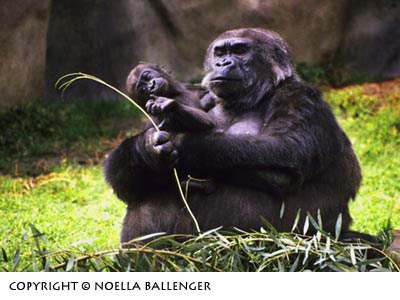
This was one of the images used in Dr Reinisch’s office. It is used to imply a comforting, mother-child relationship. It offers soothing comfort to young patients. This is most important in medical settings.
In another area of this hospital, near the surgery waiting room there was a large image of a bright and beautiful red rose. Lovely image … but imagine having to wait for hours looking at a blood red rose, to find out the result of a loved one’s surgery. And I still remember walking into an AIDs area of one hospital where patients were living their last moments. In the hall was a stunning collection of modern art that had been donated to the hospital … brutal red and vivid yellow splashes of color in dark black backgrounds gave the feeling of restlessness and dynamic energy. But is this what someone who is clutching to the last moment of their lives wants to see? Art work and photography doesn’t need to be bland or sugar sweet but it does need to be appropriate to its settings.
From these experiences in doing consulting work and from my studies I realized the necessity of hard research. It was important for me to understand the general kind of procedures that would be taking place near that installation in order to provide the selection committee with the kind of images that would be most suitable. Other things needed to be considered as well. Working with decorators, designers, architects and medical personnel, I discovered a wealth of information that allowed me to understand the function, physical problems and durability needs of the facility. Entering this world isn’t all about beauty and your favorite shot. Durability of the installation, medical building codes and practical considerations for the staff and maintenance department is also very important. There are many problems to be solved but always in the front of your mind are the effects on the well being of the patient and the caring staff.
Over the years I have done a number of installations of photography in medical facilities. One of the early ones I did was for Dr. John F. Reinisch at the USC Children’s Hospital in Los Angeles, California. Dr. Reinisch contacted me to assist in planning his new office. He is an outstanding children’s plastic surgeon and he wanted something very special for his young patients. They needed to have a pleasant place to come. The waiting room needed to be dark because of the severity of the appearance of some of the children. We chose to do animals because they are both interesting and entertaining.
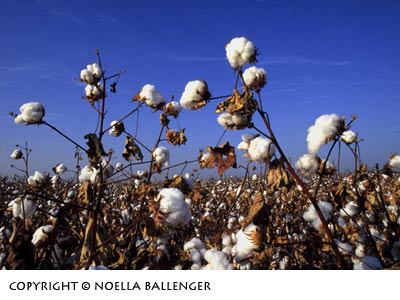
“In Kern County, cotton has long been king. Not only is it one of our most abundant crops, it is also one of the most used, with nearly every part of the plant serving a purpose. At harvest time, the fields turn a beautiful snowy white as the cotton bolls open. Once harvested, the cotton bolls are taken to the gin where the fibers and seeds are separated. Cotton fibers are woven into fabric. The seeds are squeezed to extract the cottonseed oil. After the oil is extracted, the seeds can then be used for livestock feed. After harvesting the bolls, even the remaining plants are put to use as they are plowed back into the soil for nutrients.” (Ming Medical Center)
In the waiting room, we installed four backlit light fixtures and inserted large transparencies of animals. In every examining room we made sure that there was an interesting photograph of an animal for the kids to see. In the treatment room (where I must admit some of the equipment even scared me), we wanted something really comforting that would tap into those natural instincts of a child seeking comfort from a mother, we put a beautiful image of baby sheep nursing its mom.
Behind the reception/appointment area, the image of a large snail crawling along an agave leaf was selected. At first, there was a lot of misunderstanding because the reception staff thought that it was a comment on the way they were performing their duties. However, the snail was selected so that the visitors (not the receptionists) would slow down. Once this was straightened out, the images became quite popular with the staff. And from the reports that I received, the kids loved having the animals to see and talk about.
One of the most interesting jobs I ever did was for Kaiser Permanente’s Ming Medical Offices in Bakersfield, California. I came into the job when the foundation for the extension of their facility was just being poured. Working closely with the facility director, Angie Cave-Brown and her staff was a joy. She wanted this facility to reflect the community and to show what Kern County was all about. Kern County is in one of California’s richest agriculture and oil areas. Kern County is also known for some wonderful recreation areas … from the Mojave Desert to the Sierra Nevada mountains. She had been raised in the area and loved it…and her love inspired me to photograph it in a way that I never really anticipated.
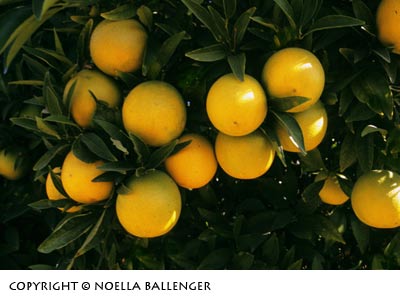
“Citrus, including oranges, limes, lemons, grapefruit, tangerines and tangelos, is the fourth largest crop in Kern County. The beautiful, bushy trees retain their glossy green leaves year-round. The types of trees grown in Kern County were selected based on the amount of heat they will receive when the fruit is ripening and the amount of cold they can tolerate in winter.” (Ming Medical Center)
I was raised a city girl and, although my mother had a farm life background, I knew nothing about agriculture or really how to proceed to learn. A friend of mine introduced me to Ray Rosales, a soil consultant. At least once a month for almost a year, I drove over 100 miles each way to meet him and spend time visiting and talking with farmers, ranchers, cattle and sheep men. I learned about the cycle of growth and farming. I became very appreciative of the hazards of the business of farming … when a bad freeze or super high temperatures could kill a crop. I walked fields of corn watching the harvest; I saw pistachio trees being shaken so that the nut crop would drop and I had the pleasure of tasting sweet, sweet grapes right from the vine. It was only then that I could really understand what I was photographing and be able to share that pleasure and vision with others.
So for the Kaiser’s Ming Medical Offices, we primarily did agriculture images for the adult section and put special signage near each image explaining what it was and how it contributed to the county. For the children, I knew that I wanted to again use comforting images of animals. For children, animals seem to be a “universal language”. But again we wanted it to be special visual and a learning area for them. I worked with the California Living Museum (CALM) in Bakersfield and was able to photograph some of their animals as well as get tremendous assistance on the small signs that we put near each photograph. Marty Markham, from California Fish and Game, lent his expertise and assistance in learning about the habits of some of the animals I needed to photograph. Horses, coyote, bear, house cat, owl and many others added to the uniqueness of the children’s area. Each time I visit the facility, I hear numerous reports about how the images are so interesting and how much the people enjoy visiting the facility. This wasn’t just a photography job for me, but one of the most fabulous learning opportunities. I am tremendously grateful for the entire experience and for the assistance and patience of all who worked with me.
More recently I did a project for the St Elizabeth Imaging Center in Red Bluff, California. Soothing patients with calming images in the ceilings gives them something to enjoy while they are having medical procedures. St Elizabeth Imaging Center was located in an area with lovely large California Oak trees. They wanted to bring their beautiful oak trees inside and have an image would give the feeling of looking up through a skylight. Again, these images allow the patient to relax more and also have a very positive effect on the workers in the center who are in windowless buildings for hours at a time and also need the soothing benefits of nature.
So my answer to “Why Nature?” is a pretty simple one for me. As a photographer, I have had wonderful opportunities to see many of nature’s wonders and to personally appreciate the sense of healing that it gave me. Being a nature photographer allows me to share the beauty that I have found in nature with others. It is wonderful knowing my images of nature have brought some of the positive benefits of healing and relaxation to both patients and medical staff.
by Noella Ballenger

Leave a Reply